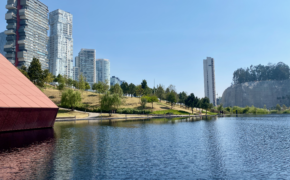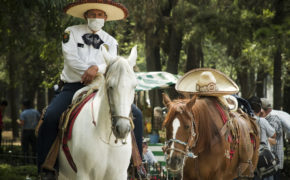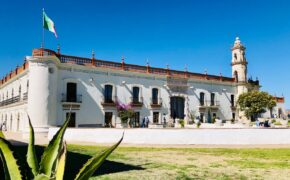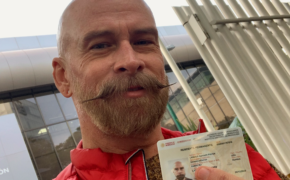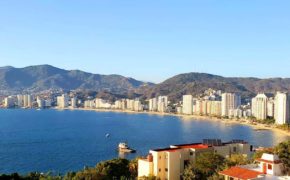Becoming a Legal Resident of Mexico
Today is kinda a big day for me in that 4 years, 4 months and 7 days after moving to Mexico, this morning I finally completed the process of becoming a permanent resident at Instituto Nacional de Migración (INM) in Mexico City. It’s actually quite an accomplishment, and in many ways it was more challenging than I expected, (looking at you, COVID-19 pandemic!) So, I thought I’d share my experience to help others considering moving to Mexico understand how this process works in real terms in basic English. That said, this post is only reporting my own personal experience. If you’re seriously considering a move to Mexico, do what I did and talk to a lot of people, including a Mexican immigration attorney, to get all your questions answered so that you’ll understand what you’re getting into before you make the commitment.
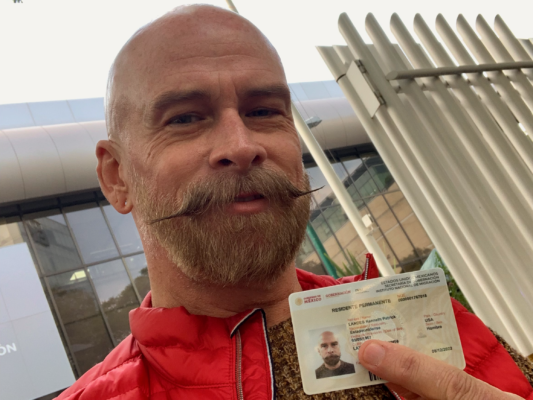
Four years and seven months after my move, I just left the building with my permanent resident visa. Next step…dual citizenship!
Permanent vs. Temporary Resident Visa
For starters, there are several ways to automatically qualify for a permanent resident visa if one owns property in Mexico or has evidence of assets to establish financial independence, including retirement income from government or private pension programs. Had I moved a year or so sooner, I might have qualified based on assets, but after being laid off from my last job in the US, I lived off my nest egg for a couple of years while looking for work before finally deciding to turn a page and try something new. I also didn’t qualify as a retiree since I moved to Mexico before reaching retirement age eligibility for US Social Security.
Employment Sponsorship
So, without investments in Mexico, evidence of assets, or retirement income, the only option available to me was to start with a temporary resident visa with employment sponsorship. Of course, that sounds simpler than it really is. In fact, I was not looking to continue my previous work in web development, UX design, marketing, branding, and graphic design here. Those kind of jobs are difficult for foreigners needing visa sponsorship to get in Mexico since there is no shortage of Mexicans looking for those jobs. As in the US, in order for a foreigner to get visa sponsorship in Mexico, there needs to be a shortage of qualified workers in Mexico for the job they’re applying to do.
In my case, I’d had the good fortune of visiting Mexico three or four times a year for several years before my move. In the process, I made a lot of friends who were always begging me to help them learn English. Learning English is really important in Mexico for professionals, university students, and international travelers. Additionally, I witnessed repeatedly during my visits hotel and restaurant staff, and street and beach vendors struggle to overcome the language barrier with clients. After doing some research, I found a reputable teacher training program in Guadalajara. They helped answer the specific questions I needed to answer before making my move. Satisfied I could make it work, I arrived in Mexico on August 2, 2018 to begin my teacher training course.
Tourist Visa on Arrival
When I arrived, I received the typical tourist visa that is given to foreigners visiting Mexico on vacation. For US citizens, it requires nothing more than a valid passport that does not expire for at least 6 months. During the flight to Mexico, travelers are given an immigration form to fill out. Upon arrival, it is reviewed in Customs (Aduanas) and signed by an official, granting the right to stay in Mexico as a visitor for up to 180 days.
A lot of foreigners use this type of visa to move here and take no further steps to formalize the immigration process. While it is technically possible to do this, it is not the best idea as it makes it more difficult to properly integrate into Mexican society. Specifically, the tourist visa does not provide a Clave Única de Registro de Población (CURP) number. This is used the way the Social Security number is used in the US, without which all sorts of important things cannot be accomplished. In Mexico, such important things include opening a bank account, getting a driver license, or accessing the public medical system. Additionally, all sorts of other services require a CURP, without which the service may be denied. Perhaps the most onerous issue, though, is that it only lasts 180 days, which means physically leaving Mexico at least twice a year to reenter as a tourist.
Mexican Consulate Visit
Toward the end of my teacher training, I received a job offer in Mexico with visa sponsorship. After moving from Guadalajara to Querétaro, the visa sponsorship process was initiated by my new employer. Within a few months, my application was approved. At this point, I was required to exit Mexico as a tourist in order to visit a Mexican consulate to have a resident visa affixed to my passport. This would allow me 6 months to return to Mexico to begin the formal immigration process. It was the holidays and I have family in San Diego, so I decided to visit them and take care of my business there. However, this procedure (trámite) can be completed at any Mexican embassy or consulate. At the consulate in San Diego, they quickly processed my paperwork and affixed the visa to a page of my US passport.
Canje Process
It’s very important when entering Mexico with this type of visa to make sure the customs agent completes this process correctly by checking the boxes “Estancia Maxima 3o días” and “CANJE”. Canje is a Spanish word for exchange used to indicate the process of exchanging the resident visa stamp received in my passport at the Mexican consulate for an official temporary resident visa card, which is the primary legal ID for an immigrant in Mexico. I re-entered Mexico crossing from the Crossborder Xpress US terminal into Aeropuerto Internacional de Tijuana. After carefully ensuring my visa was properly processed, I continued to Mexico City, where I had booked an appointment at INM to complete the canje process.
Temporary Resident Visa
In hindsight, this first visit was the most intimidating. My Spanish wasn’t quite up to speed yet, and nobody at INM speaks English. At the time, the process required several visits on two days. During the first visit, I presented my passport and all the paperwork provided by the immigration attorney my employer hired to help me through the process. I also had to present evidence of payment of the fees, which were deposited to a Mexican government account in advance of my appointment at the branch of a Mexican bank. I was instructed to keep an eye on my email to find out when to return to continue the process. After a few days, the email arrived, and I returned to INM. This time, I had to bring my own photos and I was fingerprinted. They printed a preview of my resident visa card for me to sign off on and told me to return that afternoon to receive the card and complete the process. I returned that afternoon and received my first temporary resident visa with permission to work and left happily, prepared to return to Querétaro to get back to work.
Understanding the CURP
Later that evening, I was looking at my card and noticed that my 18-character CURP made some sense to me. It included four letters corresponding to my initials, with an X where my maternal last name would be. In Mexico, people’s last names are composed of both their father’s last name and their mother’s last name. For foreigners whose mother’s name is not part of their legal name, this initial is replaced with an X. After these initials, the first six numbers resembled my date of birth in YYMMDD format, followed by six more apparently random letters and two more numbers. While my CURP made some sense to me, I could see that even though my date of birth was correct on the card in MM/DD/YYYY format, a clerical error had been made entering my birthdate when generating my CURP.
I decided to return to INM in the morning to see if I could get this correct. At this point, things became complicated. After being told to return later that afternoon to pick up a corrected version of my card, I was dismayed to receive the same card again. I was informed that although the number was entered incorrectly, I would need to initiate another procedure to have it changed. They assured me that all the same my resident visa was valid and I could go about my business in the meantime, so I decided to return to Querétaro to get to work. That ended up being a bad decision that took me a while to sort out. I didn’t end up getting my CURP corrected for another year in a separate visit following from the first renewal of my visa.
As I explained before, the temporary resident card becomes your primary ID within Mexico, which makes the CURP your primary identifier. Having an incorrect CURP caused me problems when I tried to open a bank account. It was also an issue when I applied for a driver’s license. In the end, I was able to get both things done, but it was necessary to explain the problem each time. For this reason, I’ve included this anecdote here as a warning. When I was presented the preview of my resident card, I did not understand how the CURP was composed, so it didn’t occur to me to inspect it carefully. So learn from the hassle I experienced that this is, in fact, how CURP is composed: 2 letters: the first two letters of your father’s last name (your legal last name coming from the US), 1 letter: either the first letter of your mother’s last name or an X if your mother’s last name is not part of your legal name, 1 letter: your first initial, 6 numbers: your date of birth in YYMMDD order, six more random letters, two more random numbers. Make sure to check this carefully when you receive your temporary resident card to ensure it is correct.
COVID-19 Impact on Temporary Resident Visa Renewals
After starting a relationship in the state of Mexico, I relocated there a few months after receiving my visa. This put my residency at risk if I didn’t find a new employer with visa sponsorship within 90 days. However, as native English speakers are sought-after English teachers in Mexico, I was able to do this and my new employer assumed sponsorship of my visa. This procedure did not require a visit to INM. My first year visa was issued in January of 2019, so it was time for my first renewal in January of 2020, which corresponds to the beginning of the COVID-19 pandemic. The morning of my appointment, I woke up at 5:30 a.m. to make the drive into Mexico City to visit INM only to receive word that INM had decided overnight to close until further notice after the first cases of COVD were detected in Mexico. INM granted automatic visa extensions to both tourists and permanent residents during this time, and I was instructed to wait for further notice.
A few weeks later, I received a new appointment to visit INM under strict COVID-19 protocols. However, along with the strict protocols came an improved fully digital process for visa renewals. The process was relocated to a new room on the top floor equipped with electronic equipment to capture fingerprints, photograph, and signature followed by immediate delivery of the new resident visa. In fact, I left within an hour of my arrival for my first, second, third visa renewal visits with my renewed visa in hand. Additionally, the second and third renewal visits were scheduled a month ahead of the expiration of my visa, which made the renewal process during the holiday season a little less inconvenient. The new and improved renewal process was very efficient, and I have nothing but praise for the way in which INM implemented this new process in short order under such challenging circumstances.
Transition to Permanent Resident Visa
Having lived in Mexico for 4 years now, I had completed the temporary resident process. This left me with three options. I could leave Mexico, apply to begin the temporary resident process again, or request that my temporary visa convert to a permanent visa on the basis of having lived here for four years. In my case, my goal from the start was to obtain my permanent visa, so there was no question what to do. The process was no different this time for me. The only difference was the type of procedure initiated by my immigration lawyer. On the day of my appointment, I simply presented my passport and the documentation prepared by my attorney. After providing again my fingerprints, photograph and signature in digital format, my permanent visa was issued to me immediately and I was on my way. It couldn’t have been simpler.
Along with a permanent visa comes a little more independence. Whereas I was previously restricted to a certain kind of work for a specific employer, I now have the right to do any type of work for any employer without the need for sponsorship. I must inform INM in the event of a change of employer, living address, marital status, or name. Other than that, I am free to conduct my life as I choose. If I decide to, I can apply for Mexican citizenship in one more year.
So there it is. It took a little over four years from start to finish. The main hiccups in my process related to not understanding the format of CURP. I had a slight delay renewing my visa the first time due to the onset of the pandemic, but from then on the renewal process and transition to permanent status was extremely streamlined. I hope sharing about my own experience becoming a permanent resident of Mexico helps to make the process smoother for others. ¡Saludos!


